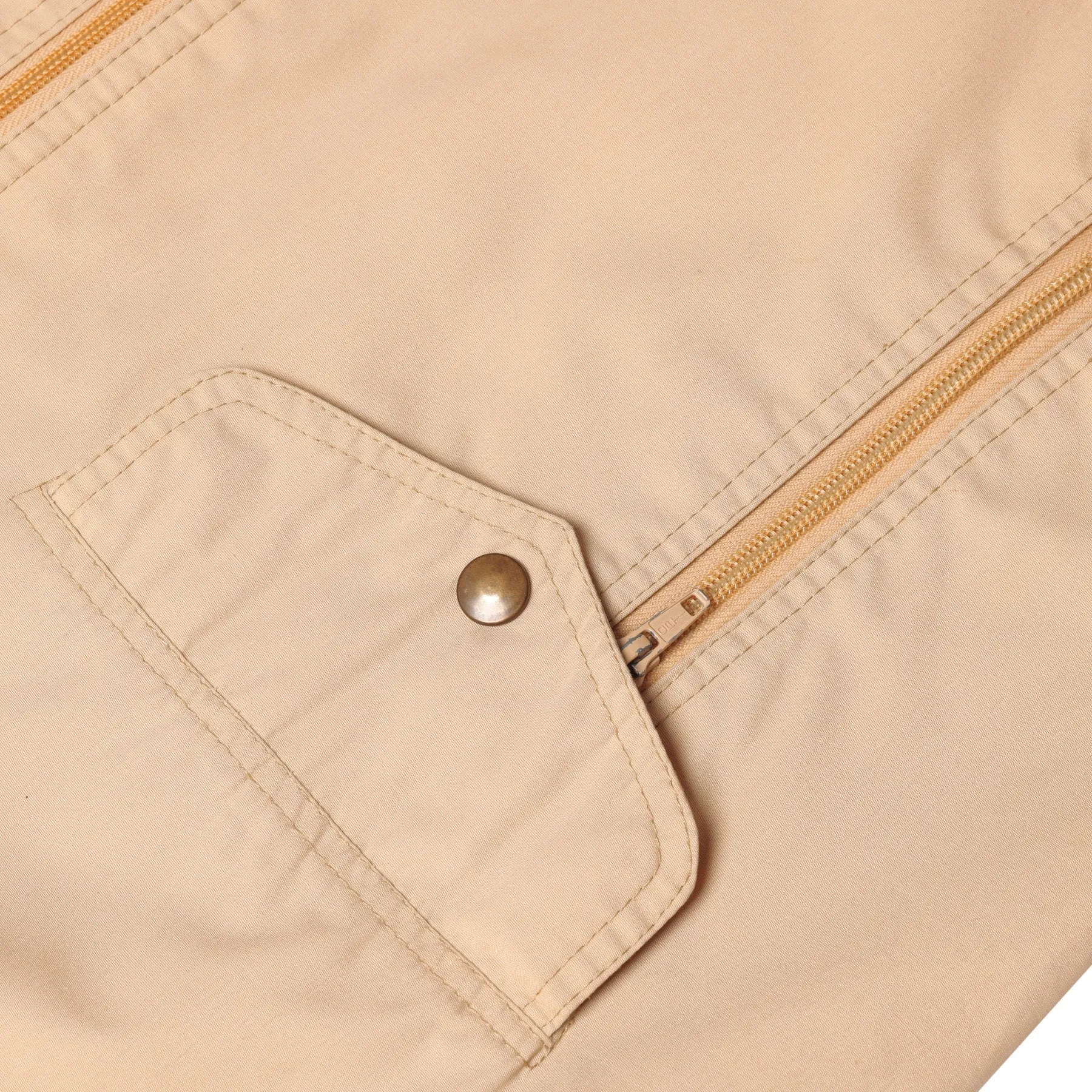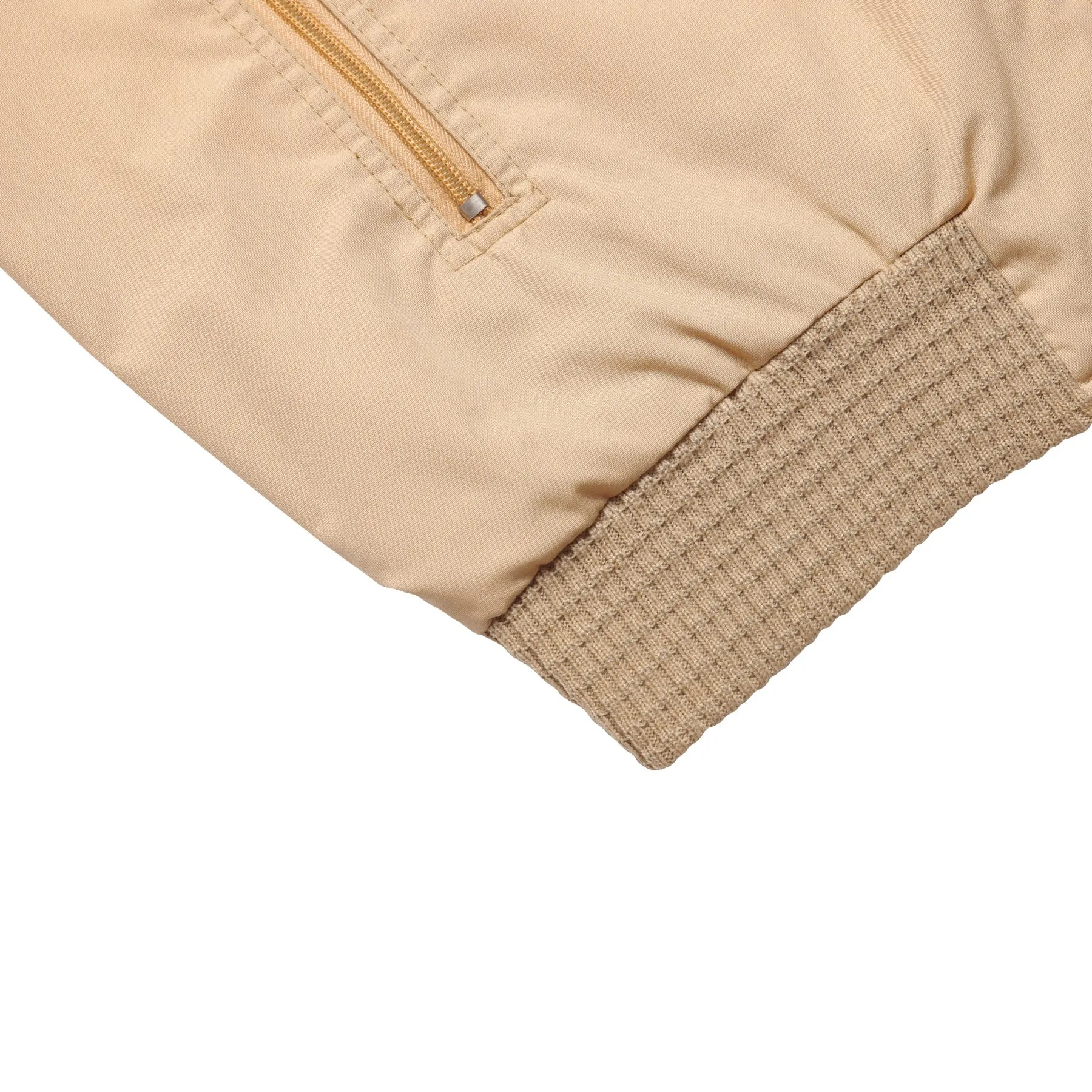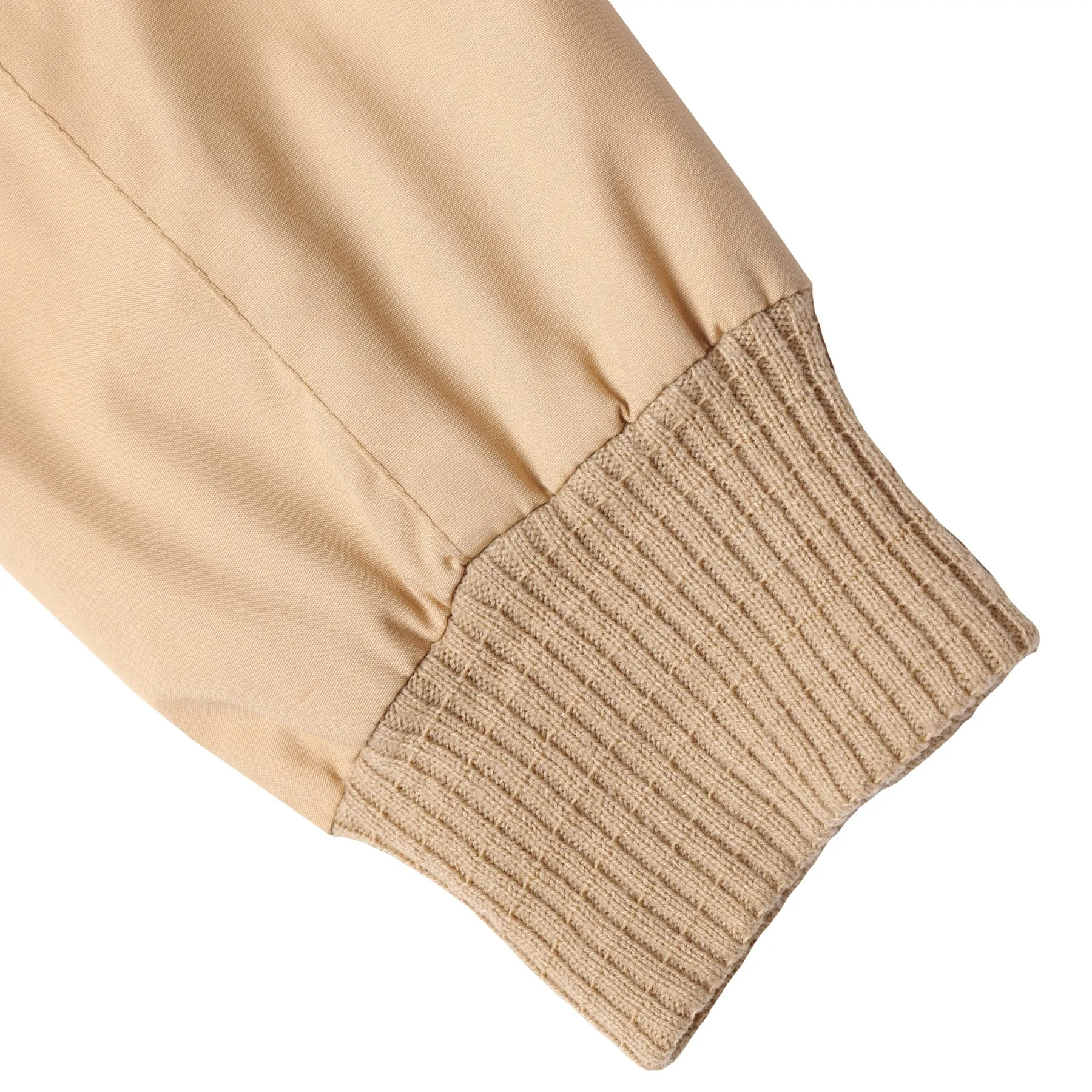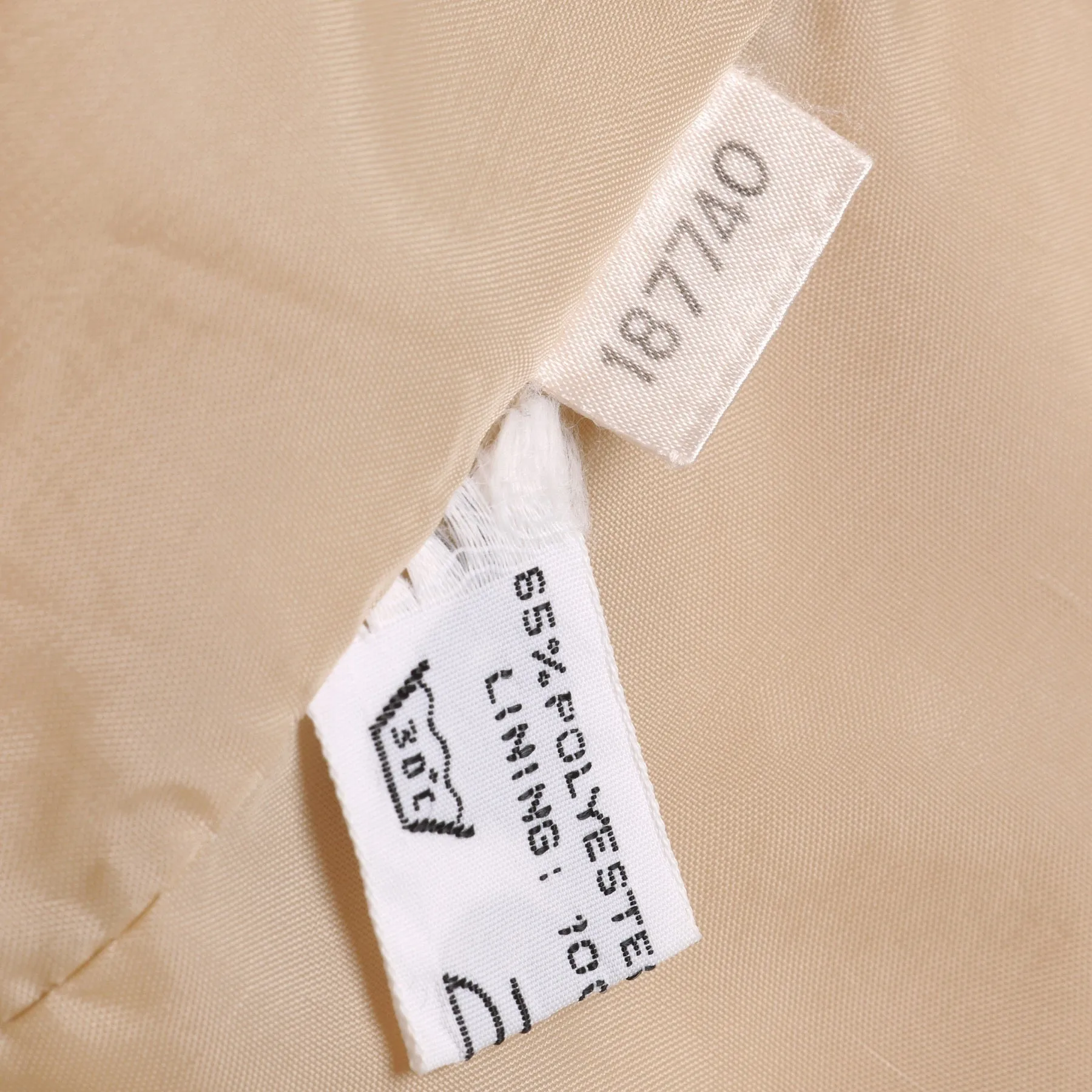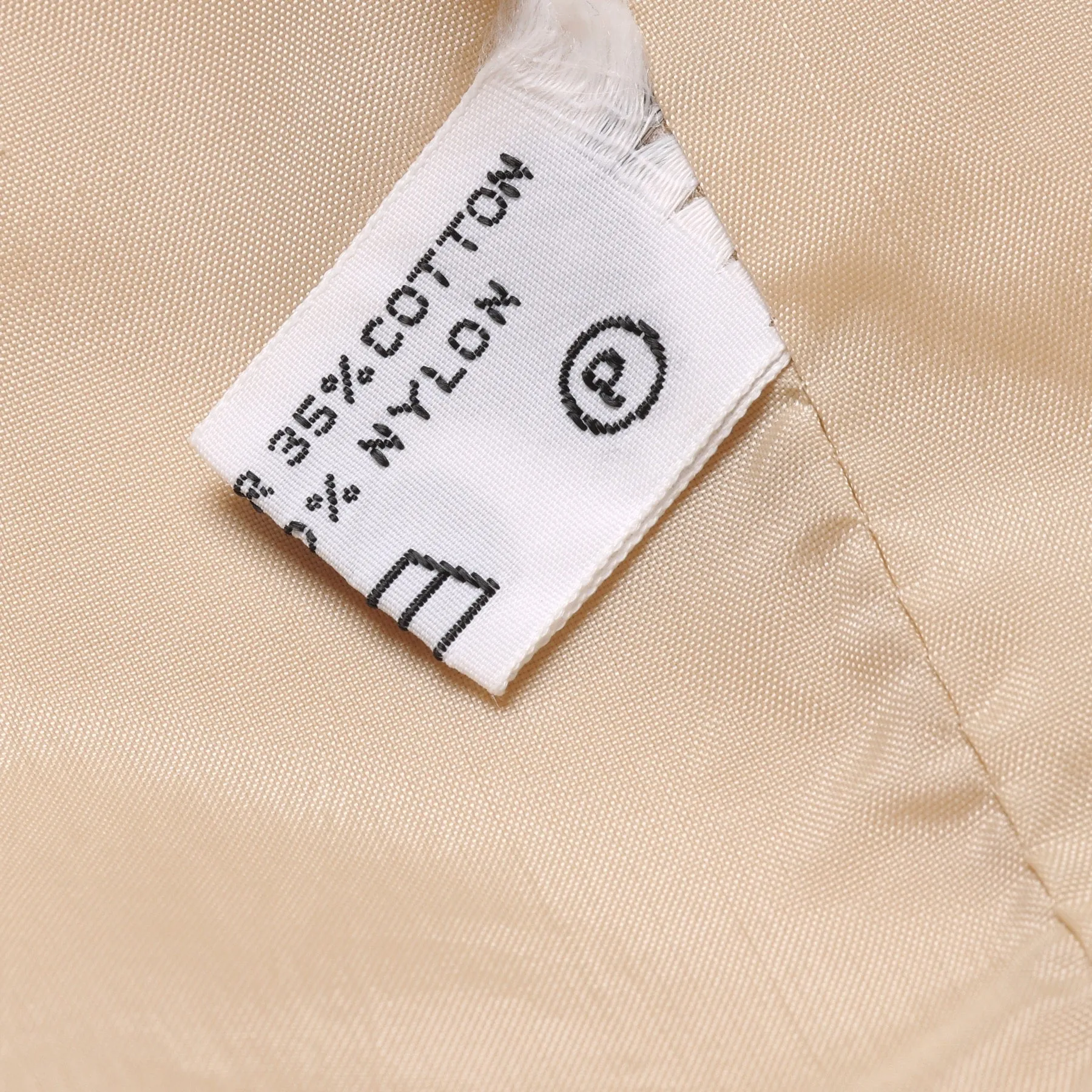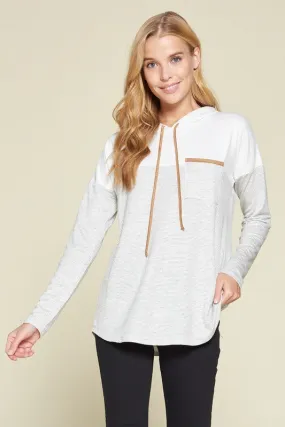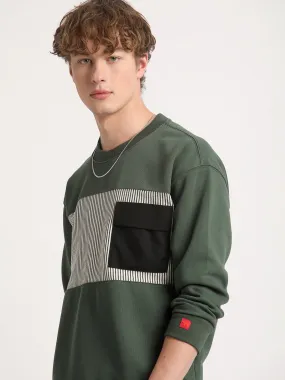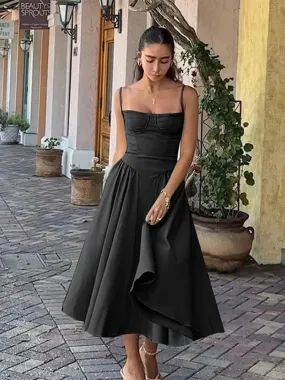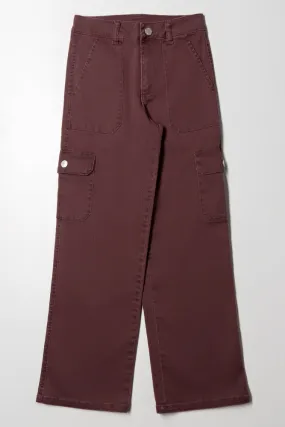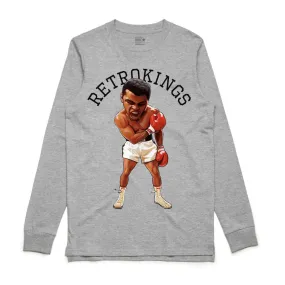Dual-entry pockets, western yoke detailing, and ribbed knit finishes reinforce a hybrid lineage of workwear, military, and suburban casualwear.
The jacket was produced as a private-label garment for European mid-tier department stores or catalog houses between the late 1970s and early 1980s, reflecting the vertically integrated mass production model that dominated much of European manufacturing during that era. The absence of branding, the European care labeling system, and the industrial production code indicate a manufacturing process likely centered in West Germany. Private-label production in this period prioritized function over brand narrative, focusing on durable, commercially viable garments intended to withstand seasonal turnover, rooted in technical pragmatism and cost-efficient design rather than an articulated designer philosophy. Occupying a significant yet often invisible position within European menswear’s historical development, private-label manufacturers were pivotal in democratizing technical outerwear features, embedding utilitarian pocketing, synthetic-cotton fabric blends, and urban-rural hybrid design languages into the mainstream. Their industrial legacy directly shaped how functional aesthetics became standardized across European casualwear from the 1960s through the 1980s, influencing both mass-market and luxury segments in later decades. Classified within the Harrington jacket typology, this garment presents hybridization between casualwear and workwear, tailored for transitional seasons where lightweight protection against wind and light rain is necessary. The design emphasizes a zippered front, elasticated ribbed cuffs and hem, and a practical ergonomic profile to facilitate ease of movement in daily suburban or light work contexts. Constructionally, the jacket employs machine lockstitching with a moderate stitch density of approximately 8–10 SPI, balancing durability with material weight management. The yoke seam is reinforced through double-needle topstitching, enhancing both structural resilience and visual articulation. Body panels are assembled via plain seams, internally finished with overlock stitching to balance production speed with internal cleanliness. The lining is installed using bagging-out techniques, ensuring smooth integration, while ribbed cuffs and waistband are serged at joining seams to preserve elasticity and shape retention under mechanical stress. Precision design elements are manifest in the sharply angled western-style front yoke, dual-entry lower pockets integrating flapped snap closures with vertical zippered compartments, and a full-length metal coil zipper framed with reinforced placket taping. Functional vertical-zip pockets, distinctively industrial in spirit, are cleanly integrated beneath the flap pockets, signaling technical utility derived from workwear traditions. Single-cap rivet-mounted snaps provide both durability and tactile reinforcement at pocket closures, minimizing stress deformation. Situated historically within the Harrington evolutionary lineage originating from Baracuta’s 1930s G9 archetype, this jacket incorporates military blouson influences (notably the M-1941 field jacket), westernwear yoke treatments, and sportswear-derived elasticated waists. By the 1970s and 1980s, these motifs had hybridized further into suburban, blue-collar, and casual citywear categories, reflecting the democratization and functional reinterpretation of earlier elite and occupational outerwear typologies. The shell fabric consists of a 65% polyester, 35% cotton blend, executed in a dense plain-weave structure, optimized for a balance of breathability, abrasion resistance, and dimensional stability. This fabric profile ensures quick drying, moderate wind resistance, and low maintenance, addressing the practical imperatives of transitional-weather casualwear. The lining, composed of lightweight polyester taffeta (~50–60 GSM estimated), facilitates frictionless movement over inner garments and enhances wearing comfort. The pattern structure builds upon a classic bomber block with subtle adaptations: the front yoke offers mild shaping and visual segmentation; sleeves are traditionally set-in with moderate sleeve head volume to support articulation; the double pocket system showcases efficient functional layering without aesthetic congestion; and the ribbed waistband and cuffs are cut with negative ease to maintain blouson volume control. The shirt-style collar is drafted flatter than a formal counterpart, reinforcing casual utility while maintaining neckline structure, integrating seamlessly with the bomber silhouette logic. Sewing and assembly techniques prioritize industrial efficiency without sacrificing technical cleanliness. Body seams and shoulder joins utilize plain seams internally overlocked for finish security. The center front zipper is set into a faced application, providing an internally clean finish with external reinforcement through narrow, evenly spaced topstitching. Flap pockets are constructed separately and topstitched, while zippered pocket entries are independently inserted into vertical welt-style openings, an advanced pattern stacking approach that maintains both functionality and surface integrity. Stitch density maintains a consistent 8–9 SPI across load-bearing seams, pocket set-ins, and topstitched contours, reinforcing long-term garment resilience. Edge finishing is handled meticulously: snap button areas and zipper endpoints are interfaced to absorb mechanical stress; zipper bases are bar-tacked to prevent separation; pocket welts are stabilized via hidden fusing or strategic staystitching to preserve crisp function over repeated use. Internally, bias binding is selectively applied to high-wear areas for fray prevention without introducing unnecessary bulk, critical for a garment relying on a gathered waistband structure. From a craft evaluation perspective, the garment demonstrates industrially high precision: flap edges align sharply with concealed zipper entries; topstitching is consistently parallel and pressure-balanced; and material handling during construction prevents tension puckering or seam misalignment. The clean execution of dual-entry pockets further indicates careful template calibration and production discipline, hallmarks of upper-tier industrial output. Special attention to the pocketing system reveals thoughtful separation of functional load paths: flap and zip pocket bags are independently constructed, reducing bulk and preventing stress transmission between closure mechanisms. The ribbed knit trims at the cuffs and waistband are produced with a wide 2x2 rib construction (~5–7 GG gauge), blending polyester and cotton fibers to ensure high elasticity, recovery, and durability, critical for garment entry and exit stress points. The plain-weave cotton-polyester shell aligns historically with several outerwear textile traditions: weathered poplin developed for military applications, tropical wool-like plain weaves designed for breathability and resilience, and lightweight synthetic-infused drill variants engineered for sportswear. Textile mills paralleling this material strategy include Olmetex (Italy) for sartorial technical outerwear fabrics, Klopman International (Italy) for robust workwear blends, British Millerain (UK) for early synthetic-enhanced poplins, and Toray Industries (Japan) for dense, high-performance synthetics. Structurally, the jacket’s panel configuration favors minimalism and manufacturing economy: two-piece sleeves with moderate scye depth, vertical integration of zippered pockets, and a controlled blouson silhouette primarily articulated through hem and cuff tension. The collar is lightly structured with sew-in interfacing, emphasizing comfort over rigidity. Set-in sleeves with slight natural sleeve head curvature optimize ergonomic mobility without introducing visual excess. Internal seams are clean-finished via overlock stitching, preserving a balance between production efficiency and garment lifespan. The psychological design language of the garment communicates pragmatic reliability and understated protection, aligning with suburban and blue-collar male consumer values in the late 20th century. The western yoke, with its subtle invocation of frontier masculinity, merges seamlessly with utilitarian zippered functionality, creating a hybridized masculine aesthetic focused on readiness and ease rather than overt stylistic assertion. Artistically, the jacket belongs firmly within the functionalist workwear tradition, synthesizing American Westernwear symbolism with European industrial casualwear pragmatism. It eschews conceptual fashion ambitions in favor of codifying postwar masculine values: practicality, endurance, and aesthetic economy. Contextually, the jacket’s production window in the late 1970s to early 1980s is substantiated by material composition (cotton-poly blends, synthetic linings), hardware choice (metal coil zippers, rivet-mounted snaps), and stylistic markers (western yoke, dual-entry pockets, knitted rib finishes), aligning it with a pivotal era in which leisurewear and workwear aesthetics were absorbed into mass-produced suburban menswear codes. Today, the jacket’s structural and aesthetic DNA finds renewed relevance within neo-workwear, archival menswear, and normcore movements. Contemporary brands such as Engineered Garments, OrSlow, Beams Plus, and A.P.C. channel similar mid-century workwear hybrids, while even minimalist-driven labels like COS indirectly inherit the industrial, non-narrative-driven functionality pioneered by private-label mass production. This jacket’s clean durability, subtle Americana referencing, and pragmatic versatility position it as a valuable archival piece within vintage, heritage, and workwear-revival markets. In final evaluation, the jacket demonstrates industrial excellence at a commercial mid-tier level: clear pattern logic, rigorous technical detailing, and material resilience appropriate to its intended transitional weather role. Its understated form, functional fidelity, and historical resonance ensure its continued viability across a range of contemporary archival, vintage, and neo-heritage fashion contexts, appealing equally to collectors, historians, and pragmatic dressers who appreciate authentic workwear-informed casualwear.
Measurements (cm):
Chest: 63
Length: 68
Shoulder: 52
Sleeve: 68
Size Conversion (approximate)
US Men’s Size: XL-XXL
EU Men’s Size: 52
-54
SKU: 015049





